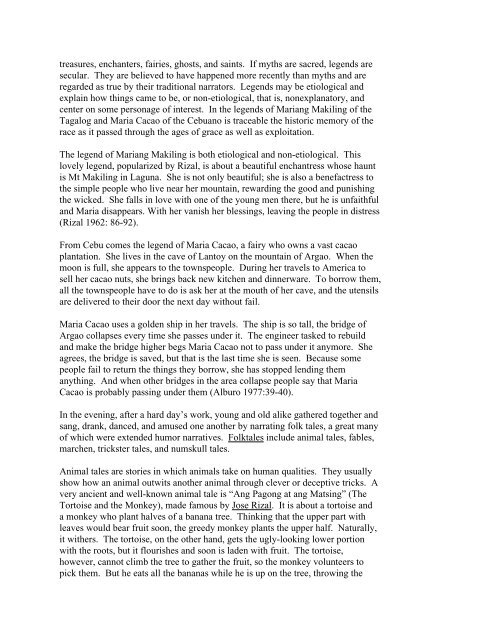THE ETHNIC TRADITION The Filipino's earliest ancestors travelled ...
THE ETHNIC TRADITION The Filipino's earliest ancestors travelled ...
THE ETHNIC TRADITION The Filipino's earliest ancestors travelled ...
You also want an ePaper? Increase the reach of your titles
YUMPU automatically turns print PDFs into web optimized ePapers that Google loves.
treasures, enchanters, fairies, ghosts, and saints. If myths are sacred, legends are<br />
secular. <strong>The</strong>y are believed to have happened more recently than myths and are<br />
regarded as true by their traditional narrators. Legends may be etiological and<br />
explain how things came to be, or non-etiological, that is, nonexplanatory, and<br />
center on some personage of interest. In the legends of Mariang Makiling of the<br />
Tagalog and Maria Cacao of the Cebuano is traceable the historic memory of the<br />
race as it passed through the ages of grace as well as exploitation.<br />
<strong>The</strong> legend of Mariang Makiling is both etiological and non-etiological. This<br />
lovely legend, popularized by Rizal, is about a beautiful enchantress whose haunt<br />
is Mt Makiling in Laguna. She is not only beautiful; she is also a benefactress to<br />
the simple people who live near her mountain, rewarding the good and punishing<br />
the wicked. She falls in love with one of the young men there, but he is unfaithful<br />
and Maria disappears. With her vanish her blessings, leaving the people in distress<br />
(Rizal 1962: 86-92).<br />
From Cebu comes the legend of Maria Cacao, a fairy who owns a vast cacao<br />
plantation. She lives in the cave of Lantoy on the mountain of Argao. When the<br />
moon is full, she appears to the townspeople. During her travels to America to<br />
sell her cacao nuts, she brings back new kitchen and dinnerware. To borrow them,<br />
all the townspeople have to do is ask her at the mouth of her cave, and the utensils<br />
are delivered to their door the next day without fail.<br />
Maria Cacao uses a golden ship in her travels. <strong>The</strong> ship is so tall, the bridge of<br />
Argao collapses every time she passes under it. <strong>The</strong> engineer tasked to rebuild<br />
and make the bridge higher begs Maria Cacao not to pass under it anymore. She<br />
agrees, the bridge is saved, but that is the last time she is seen. Because some<br />
people fail to return the things they borrow, she has stopped lending them<br />
anything. And when other bridges in the area collapse people say that Maria<br />
Cacao is probably passing under them (Alburo 1977:39-40).<br />
In the evening, after a hard day’s work, young and old alike gathered together and<br />
sang, drank, danced, and amused one another by narrating folk tales, a great many<br />
of which were extended humor narratives. Folktales include animal tales, fables,<br />
marchen, trickster tales, and numskull tales.<br />
Animal tales are stories in which animals take on human qualities. <strong>The</strong>y usually<br />
show how an animal outwits another animal through clever or deceptive tricks. A<br />
very ancient and well-known animal tale is “Ang Pagong at ang Matsing” (<strong>The</strong><br />
Tortoise and the Monkey), made famous by Jose Rizal. It is about a tortoise and<br />
a monkey who plant halves of a banana tree. Thinking that the upper part with<br />
leaves would bear fruit soon, the greedy monkey plants the upper half. Naturally,<br />
it withers. <strong>The</strong> tortoise, on the other hand, gets the ugly-looking lower portion<br />
with the roots, but it flourishes and soon is laden with fruit. <strong>The</strong> tortoise,<br />
however, cannot climb the tree to gather the fruit, so the monkey volunteers to<br />
pick them. But he eats all the bananas while he is up on the tree, throwing the
















